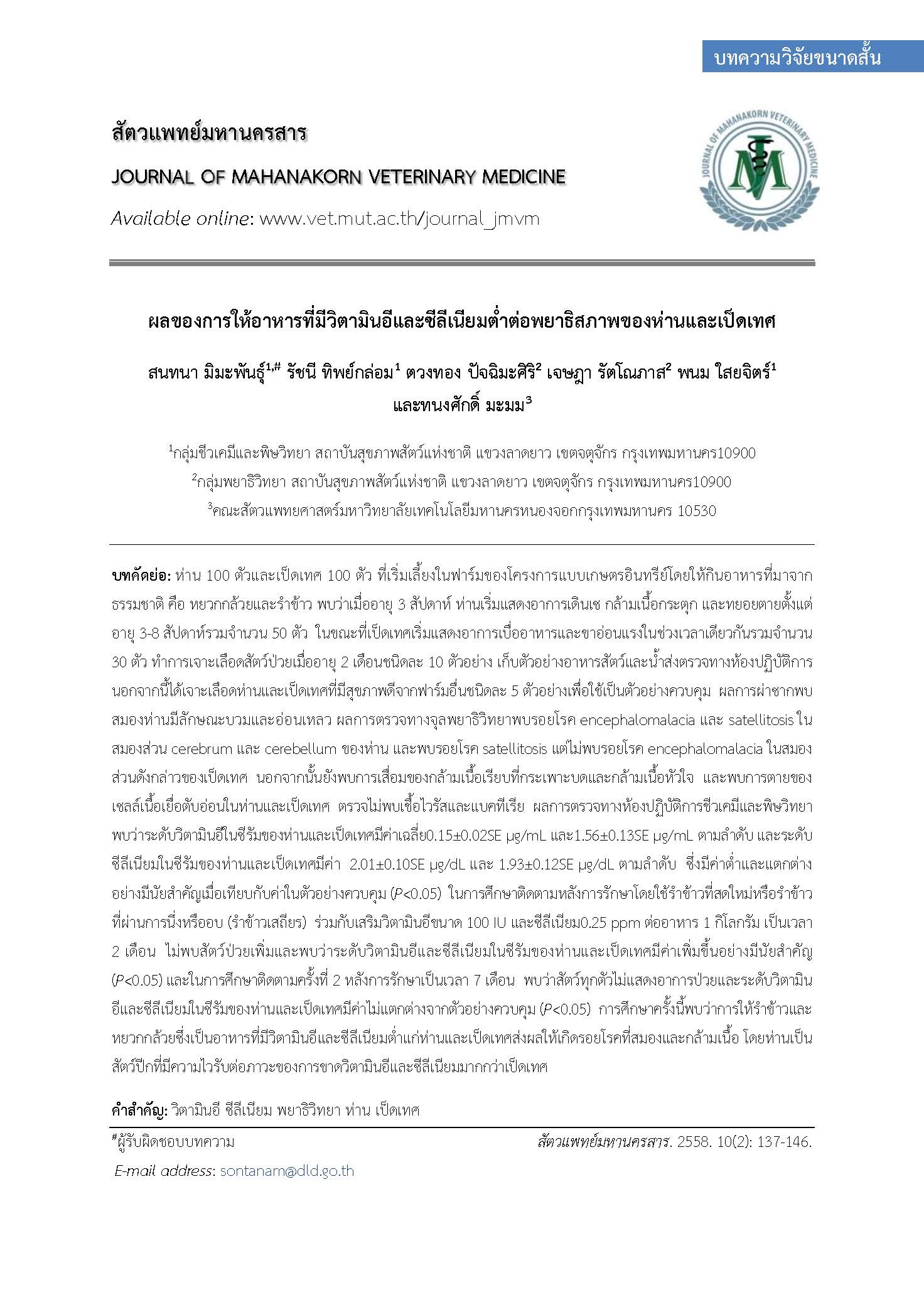Effects of Vitamin E and Selenium Deficient Diets on the Pathology of Geese and Muscovy Ducks
Main Article Content
Abstract
This study 100 geese and 100 Muscovy ducks were fed diets of banana stalk and rice bran. At 3 weeks of age, the geese showed ataxia, myoclonus and finally died. The total numbers of geese dying from 3 to 8 weeks of age are 50. Meanwhile, 30 Muscovy ducks showed anorexia, ataxia and no mortality was found. Three geese and three Muscovy affected carcasses were necropsied. Blood samples from affected birds together with feed and water were collected. Besides, blood samples from 5 healthy geese and Muscovy ducks from another farm were collected as control samples. Macroscopically, the most prominent lesions were soften and swollen brains in geese. Microscopically, encephalomalacia and diffuse satellitosis were found in cerebrum and cerebellum of affected geese while diffuse satellitosis without encephalomalacia was found in cerebrum and cerebellum of Muscovy ducks. In addition, degeneration of the gizzard smooth-muscle cells and cardiac-muscle cells, necrosis of pancreatic acinar cells were found in both affected geese and Muscovy ducks. No bacteria and virus were found from all specimens. Importantly, the average concentration of vitamin E in geese and Muscovy ducks was 0.15±0.02SE µg/mL and 1.56±0.13SE µg/mL, respectively which were significantly (P<0.05) lower than concentrations in unaffected birds. Furthermore, the average concentration of Selenium (Se) in geese and Muscovy ducks were 2.01±0.10SE µg/dL and 1.93±0.12SE µg/dL, respectively, which were significantly (P<0.05) lower than concentrations in unaffected birds. In the follow-up study, 2 months after supplementation with vitamin E 100 IU and Se 0.2 mg/kg of diet, the conditions had improved and the serum concentrations of vitamin E and Se were significantly higher than when birds were on the banana stalk and rice bran diet (P<0.05) and at 7 months on the second follow-up study, all birds were healthy and the serum concentrations of vitamin E and Se were the same as control birds. It was found that the feeding of banana stalk and rice bran which is considered to be vitamin E and Se deficient could affect brain lesions and muscular dystrophy in geese and Muscovy ducks. The data also suggests that geese are more sensitive to vitamin E and Se than Muscovy ducks.
Article Details
References
Combs, G.F. and Hady, M.N. 1991. Selenium involved with vitamin E in preventing encephalomalacia in the chick. FASEB Journal. 5: A714.
Dhillon, A.S. and Winterfield, R.W. 1983. Selenium-Vitamin E deficiency in captive wild ducks. Avian Dis. 27(2): 527-30.
Garland, P.W. and Pritchard, S. 2008. Nutritional disorders. In: Poultry diseases 6th ed. edited by Pattison, M., McMullin, P.F., Bradbury, J.M. and Alexander, D.J. Elsevier Limited. China. P.517-519.
Ikumo, H.1980. Comparison in inducing effect on vitamin E deficiency symptoms in chicks between dilauryl succinate and unsaturated fatty acids. J. Nutr. 110: 2045-2050.
Klasing, K. C. and Austic, R. E. 2003.Nutritional diseases. In: diseases of poultry 11st ed. Edited by Saif, Y.M., Barnes, H.J., Fadly, A.M., Glisson, J.R., McDougald, L.R. and Swayne, D.E. Iowa State Press, P. 1027-1036.
Linfield, W.M., Serota, S. andSivieri, L. 1985. Lipid-lipase interaction: a new method for the assay of lipase activity. J. Am. Oil Chem. Soc. 62(7): 1152-1154.
Mezes, M., Surai, P., Salyi, G., Speake, B.K., Gaal, T. and Maldjian, A. 1997. Nutritional metabolic diseases of poultry and disorders of the biological antioxidant defence system. Acta Ve.t Hung. 45(3):349-60
Nouguchi, T., Cantor, A.H. and Scott, M.L. 1973. Mode of action of selenium and vitamin E in prevention of exudative diathesis in chicks. J. Nutr. 103: 1502-1511.
Poyyamozhi, V.S. and Kadirvel, R. 1986. The value of banana stalk as a feed for goats. Anim. Feed Sci. and Tech. 15(2): 95-100.
Quinn, P.J., Carter, M. E., Markey, B.K. and Carter, G.R. 1998. Bacterial Pathogens: Microscopy, Culture and Identification. In: Clinical Veterinary Microbiology. Mosby International, London. P. 21-66.
Surai, P.F. 2002. Selenium in Poultry Nutrition: 1. Antioxidant properties, deficiency and Toxicity. World’s Poultry Science Journal. 58: 333-347.
Thompson, J.N. and Scott, M.L. 1969. Role of Selenium in the nutrition of the chick. J. Nutr. 97: 335-342.
Van Vleet, J.F. and Ferrans, V.J. 1976. Ultrastructural changes in sketetal muscle of selenium-vitamin E deficiency chicks. Am. J. Vet. Res. 37: 1081-1089.
Viswanathan, K., Kadirvel, R. and Chandrasekaran, D. 1989. Nutritive Values of Banana Stalk (Musacavendishi) as a feed for sheep. Anim. Feed Sci. and Tech. 22(4): 327-332.


